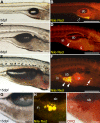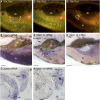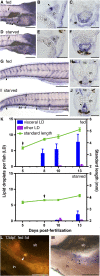Ontogeny and nutritional control of adipogenesis in zebrafish (Danio rerio)
- PMID: 19366995
- PMCID: PMC2724053
- DOI: 10.1194/jlr.M800590-JLR200
Ontogeny and nutritional control of adipogenesis in zebrafish (Danio rerio)
Abstract
The global obesity epidemic demands an improved understanding of the developmental and environmental factors regulating fat storage. Adipocytes serve as major sites of fat storage and as regulators of energy balance and inflammation. The optical transparency of developing zebrafish provides new opportunities to investigate mechanisms governing adipocyte biology, however zebrafish adipocytes remain uncharacterized. We have developed methods for visualizing zebrafish adipocytes in vivo by labeling neutral lipid droplets with Nile Red. Our results establish that neutral lipid droplets first accumulate in visceral adipocytes during larval stages and increase in number and distribution as zebrafish grow. We show that the cellular anatomy of zebrafish adipocytes is similar to mammalian white adipocytes and identify peroxisome-proliferator activated receptor gamma and fatty acid binding protein 11a as markers of the zebrafish adipocyte lineage. By monitoring adipocyte development prior to neutral lipid deposition, we find that the first visceral preadipocytes appear in association with the pancreas shortly after initiation of exogenous nutrition. Zebrafish reared in the absence of food fail to form visceral preadipocytes, indicating that exogenous nutrition is required for adipocyte development. These results reveal homologies between zebrafish and mammalian adipocytes and establish the zebrafish as a new model for adipocyte research.
Figures






Similar articles
-
MicroRNA-27b Depletion Enhances Endotrophic and Intravascular Lipid Accumulation and Induces Adipocyte Hyperplasia in Zebrafish.Int J Mol Sci. 2017 Dec 29;19(1):93. doi: 10.3390/ijms19010093. Int J Mol Sci. 2017. PMID: 29286302 Free PMC article.
-
Fat Cell and Fatty Acid Turnover in Obesity.Adv Exp Med Biol. 2017;960:135-160. doi: 10.1007/978-3-319-48382-5_6. Adv Exp Med Biol. 2017. PMID: 28585198 Review.
-
Insights into in vivo adipocyte differentiation through cell-specific labeling in zebrafish.Biol Open. 2021 Sep 15;10(9):bio058734. doi: 10.1242/bio.058734. Epub 2021 Sep 9. Biol Open. 2021. PMID: 34409430 Free PMC article.
-
Adipogenesis in fish.J Exp Biol. 2018 Mar 7;221(Pt Suppl 1):jeb161588. doi: 10.1242/jeb.161588. J Exp Biol. 2018. PMID: 29514876 Review.
-
In vivo analysis of white adipose tissue in zebrafish.Methods Cell Biol. 2011;105:63-86. doi: 10.1016/B978-0-12-381320-6.00003-5. Methods Cell Biol. 2011. PMID: 21951526 Free PMC article.
Cited by
-
Plexin D1 determines body fat distribution by regulating the type V collagen microenvironment in visceral adipose tissue.Proc Natl Acad Sci U S A. 2015 Apr 7;112(14):4363-8. doi: 10.1073/pnas.1416412112. Epub 2015 Mar 23. Proc Natl Acad Sci U S A. 2015. PMID: 25831505 Free PMC article.
-
Transcriptome analysis of anti-fatty liver action by Campari tomato using a zebrafish diet-induced obesity model.Nutr Metab (Lond). 2011 Dec 13;8:88. doi: 10.1186/1743-7075-8-88. Nutr Metab (Lond). 2011. PMID: 22152339 Free PMC article.
-
Methodological advancements in organ-specific ectopic lipid quantitative characterization: Effects of high fat diet on muscle and liver intracellular lipids.Mol Metab. 2023 Feb;68:101669. doi: 10.1016/j.molmet.2023.101669. Epub 2023 Jan 12. Mol Metab. 2023. PMID: 36642092 Free PMC article.
-
High Throughput Danio Rerio Energy Expenditure Assay.J Vis Exp. 2016 Jan 27;(107):e53297. doi: 10.3791/53297. J Vis Exp. 2016. PMID: 26863590 Free PMC article.
-
MicroRNA-27b Depletion Enhances Endotrophic and Intravascular Lipid Accumulation and Induces Adipocyte Hyperplasia in Zebrafish.Int J Mol Sci. 2017 Dec 29;19(1):93. doi: 10.3390/ijms19010093. Int J Mol Sci. 2017. PMID: 29286302 Free PMC article.
References
-
- Department of Health and Human Services (2001). The Surgeon General's Call to Action to Prevent and Decrease Overweight and Obesity. Public Health Service, Washington, DC
-
- Gesta S., Tseng Y. H., Kahn C. R. 2007. Developmental origin of fat: tracking obesity to its source. Cell. 131: 242–256 - PubMed
-
- Fruhbeck G., Gomez-Ambrosi J., Muruzabal F. J., Burrell M. A. 2001. The adipocyte: a model for integration of endocrine and metabolic signaling in energy metabolism regulation. Am. J. Physiol. Endocrinol. Metab. 280: E827–E847 - PubMed
Publication types
MeSH terms
Substances
Grants and funding
LinkOut - more resources
Full Text Sources
Other Literature Sources
Molecular Biology Databases
Research Materials

